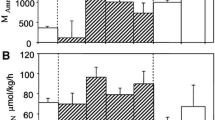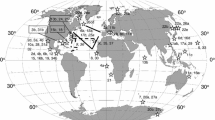Abstract
Direct calorimetry was employed to measure the energy metabolism of infaunal bivalves, Abra tenuis, collected from a tidal lagoon in the Fleet, southern England, in June 1989, at various oxygen partial pressures. A significant anaerobic component (i.e., 20% of total metabolic rate) was detected under normoxia, presumably brought about by the intermittent ventilatory activity of this bivalve under these conditions. Under hypoxia (2.3 to 10 kPa, or 11 to 48% of full air saturation), however, the energy metabolism was maintained fully aerobic; the measured heat equivalent of oxygen uptake was not significantly different from the theoretical ranges for fully aerobic catabolism. Under anoxia, the rate of heat dissipation was reduced to 5–6% of the normoxic rate of heat dissipation. This conserves energy expenditure and would thus increase resistance of A. tenuis to anoxia or emersion. Physiological compensation by A. tenuis under conditions of declining oxygen tension involved a marked increase in ventilation rate. Comparison between fed and starved individuals indicated that costly physiological processes, such as digestion, absorption and growth declined at 10 and 5 kPa and were arrested at PO 2 (oxygen partial pressure) levels below 2.3 kPa. The present study provides evidence that there are no major differences between the metabolic responses of epifaunal suspension-feeding (eg. Mytilus edulis) and infaunal deposit-feeding (eg. A. tenuis) bivalves when exposed to environmental hypoxic stress.
Similar content being viewed by others
Literature cited
Bachelet, G. (1989). Recruitment in Abra tenuis (Montagu) (Bivalvia, Semelidae), a species with direct development and protracted meiobenthic phase. In: Ryland, J. S., Tyler, P. A. (eds.) Reproduction, genetics and distribution of marine organisms. Olsen and Olsen, Fredensborg, Denmark, p. 23–30
Bayne, B. L. (1971a). Oxygen consumption by three species of lamellibranch molluses in declining ambient oxygen tension. Comp. Biochem. Physiol. 40A: 955–970
Bayne, B. L. (1971b). Ventilation, the heart beat and oxygen uptake by Mytilus edulis (L.) in declining oxygen tension. Comp. Biochem. Physiol 40A: 1065–1085
Bayne, B. L. (1976). Marine mussels their ecology and physiology. Cambridge University Press, Cambridge
Brand, A. R., Morris, D. J. (1984). The respiratory responses of the dog cockle Glycymeris glycymeris (L.) to declining environmental oxygen tension. J. exp. mar. Biol. Ecol. 83: 89–106
Brand, A. R., Taylor, A. C. (1974). Pumping activity of Arctica islandica (L.) and some other common bivalves. Mar. Behav. Physiol. 3: 1–15
Famme, P., Knudsen, J., Hansen, E. S. (1981). The effects of oxygen on the aerobic-anaerobic metabolism of the marine bivalve, Mytilus edulis L. Mar. Biol. Lett. 2: 345–351
Gibbs, P. E. (1984). The population cycle of the bivalve Abra tenuis and its mode of reproduction. J. mar. biol. Ass. U.K. 64: 791–800
Gnaiger, E. (1983). Heat dissipation and energy efficiency in animal anoxibiosis: economy contra power. J. exp. Zool. 228: 471–490
Gnaiger, E., Shick, J. M., Widdows, J. (1989). Metabolic microcalorimetry and respirometry of aquatic animals. In: Bridges, C. R., Bulter, P. J. (eds.) Techniques in comparative respiratory physiology: an experimental approach. Cambridge University Press, Cambridge, p. 113–135
Herreid, C. F. II. (1980). Hypoxia in invertebrates. Comp. Biochem. Physiol. 67A: 311–320
Hughes, T. G. (1973). Deposit feeding in Abra tenuis (Bivalvia: Tellinacea). J. Zool., Lond. 171: 499–512
Hughes, T. G. (1975). The sorting of food particles by Abra sp. (Bivalvia: Tellinacea). J. exp. mar. Biol. Ecol. 20: 137–156
Hughes, T. G. (1977). The processing of food material within the gut of Abra tenuis (Bivalvia: Tellinacea). J. mollusc. Stud. 43: 162–180
Nott, P. L. (1980). Reproduction in Abra alba (Wood), and Abra tenuis (Montagu) (Tellinacea, Scrobiculariidae). J. mar. biol. Ass. U.K. 60: 465–479
Pamatmat, M. M. (1980). Facultative anaerobiosis of benthos. In: Tenore, K. R., Coull, B. C. (eds) Marine benthic dynamics. University of South Carolina Press, Columbia, p. 69–90
Pamatmat, M. M. (1983). Measuring aerobic and anaerobic metabolism of benthic infauna under natural conditions. J. exp. Zool. 228: 405–413
Shick, J. M., Gnaiger, E., Tyler, S., Woodward, M. S. (1987). Metabolism, biochemical composition and ultrastructure of aerobic and anoxic Mulinia lateralis. Am. Zool. 27: 167
Shumway, S. E., Scott, T. M., Shick J. M. (1983). The effects of anoxia and hydrogen sulphide on survival, activity and metabolic rate in the coot clam, Mulinia lateralis (Say). J. exp. mar. Biol. Ecol. 71: 135–146
Taylor, A. C., Brand, A. R. (1975). A comparative study of the respiratory responses of the bivalves Arctica islandica (L.) and Mytilus edulis L. to declining oxygen tension. Proc. R. Soc. Lond. (Ser. B) 190: 443–456
Wang, W. X., Widdows, J. (in press). Metabolic responses of the common mussel, Mytilus edulis, to hypoxia and anoxia. Mar. Ecol. Prog. Ser.
Widdows, J. (1973). Effect of temperature and food on the heart beat, ventilation rate and oxygen uptake of Mytilus edulis. Mar. Biol. 20: 269–276
Widdows, J. (1987). Application of calorimetric methods in ecological studies. In: James, A. M. (ed.) Thermal and energetic studies of cellular biological systems. Wright, Bristol, p. 182–215
Widdows, J. (1989). Calorimetric and energetic studies of marine bivalves. In: Wiesel, W., Gnaiger, E. (eds.) Energy transformations, in cells and organisms. Georg Thieme Verlag, Stuttgart, New York, p. 145–154
Widdows, J., Hawkins, A. J. S. (1989). Partitioning of rate of heat dissipation by Mytilus edulis into maintenance, feeding and growth components. Physiol. Zoöl. 62: 764–784
Widdows, J., Newell, R. I. E., Mann, R. (1989). Effects of hypoxia and anoxia on survival, energy metabolism and feeding of oyster larvae (Crassostrea virginica, Gmelin). Biol. Bull. mar. biol. Lab., Woods Hole 177: 154–166
Author information
Authors and Affiliations
Additional information
Communicated by J. Grassle, New Brunswick
Rights and permissions
About this article
Cite this article
Wang, W.X., Widdows, J. Calorimetric studies on the energy metabolism of an infaunal bivalve, Abra tenuis, under normoxia, hypoxia and anoxia. Marine Biology 116, 73–79 (1993). https://doi.org/10.1007/BF00350733
Received:
Accepted:
Issue Date:
DOI: https://doi.org/10.1007/BF00350733




